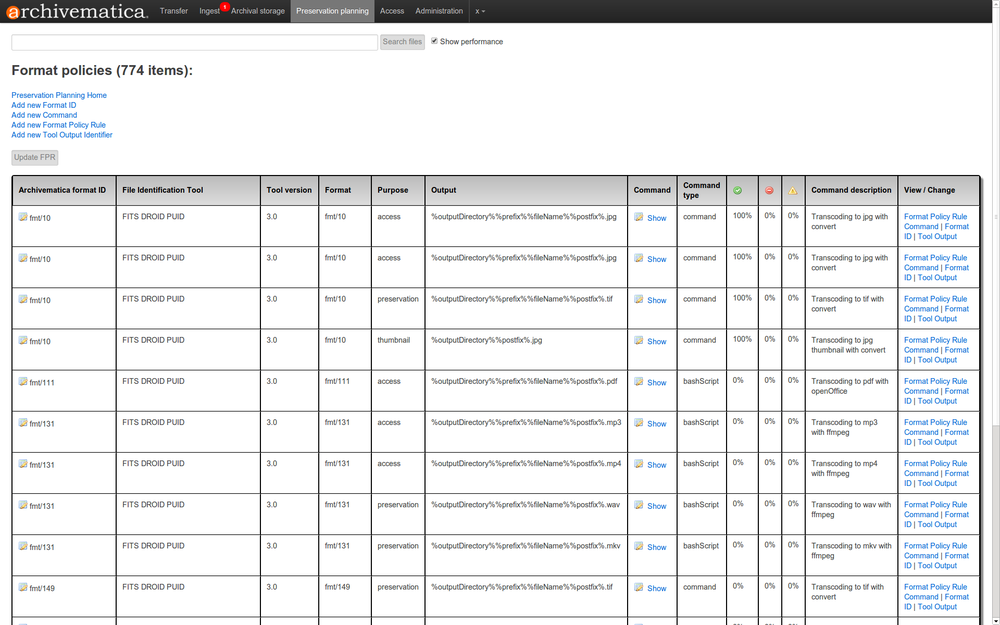Difference between revisions of "UM preservation planning"
| (12 intermediate revisions by 3 users not shown) | |||
| Line 1: | Line 1: | ||
| − | [[Main Page]] > [[Documentation]] > [[User Manual|User manual]] > [[User manual 0. | + | [[Main Page]] > [[Documentation]] > [[User Manual|User manual]] > [[User manual 0.10]] > Preservation planning |
== General description == | == General description == | ||
| − | + | Archivematica's primary preservation strategy is to normalize files to preservation and access formats upon ingest. The preservation copies are added to the AIP and the access copies are used to generate a DIP for upload to the access system. Note that the original files are always kept, to allow for different preservation actions in the future, such as normalization to different archival formats or emulation. | |
| + | |||
| + | Not all files can be normalized on ingest. For example, for some filetypes like CAD drawings or Microsoft Visio files there are no available Linux-based open-source tools to handle the conversions and/or no agreed upon preservation formats. In addition, some filetypes such as Microsoft Word documents are not necessarily in the best preservation format but are still so ubiquitous and well-supported that they need not be normalized at the present time. In these cases, the files are kept in their original formats; format risk assessment and monitoring tools will be added to future releases of Archivematica. | ||
== The Preservation planning tab == | == The Preservation planning tab == | ||
| − | + | The Preservation planning tab displays the local Format Policy Registry (FPR) | |
| − | + | * Administrative users can add or edit format policies using forms on this page. Detailed instructions are in the Administrator manual under [[Administrator_manual_0.10#Format_Policy_Registry_.28FPR.29|Format Policy Registry (FPR)]] | |
| − | + | ** A format policy consists of the business rules and tool commands for format normalization. | |
| − | + | ** The FPR lists all of Archivematica's default format policy rules. | |
| − | + | ** In your Archivematica 0.10-beta instance you can download updates from the FPR by clicking on Update FPR. | |
| − | [[ | + | * Clicking on Show performance will show the success, failure and warning rate of any given format policy. |
| + | </div> | ||
| + | |||
| + | <div class="clearfix"> | ||
| + | |||
| + | </div> | ||
| + | [[File:FprShow-10.png|1000px|center]] | ||
Latest revision as of 17:50, 29 April 2013
Main Page > Documentation > User manual > User manual 0.10 > Preservation planning
General description[edit]
Archivematica's primary preservation strategy is to normalize files to preservation and access formats upon ingest. The preservation copies are added to the AIP and the access copies are used to generate a DIP for upload to the access system. Note that the original files are always kept, to allow for different preservation actions in the future, such as normalization to different archival formats or emulation.
Not all files can be normalized on ingest. For example, for some filetypes like CAD drawings or Microsoft Visio files there are no available Linux-based open-source tools to handle the conversions and/or no agreed upon preservation formats. In addition, some filetypes such as Microsoft Word documents are not necessarily in the best preservation format but are still so ubiquitous and well-supported that they need not be normalized at the present time. In these cases, the files are kept in their original formats; format risk assessment and monitoring tools will be added to future releases of Archivematica.
The Preservation planning tab[edit]
The Preservation planning tab displays the local Format Policy Registry (FPR)
- Administrative users can add or edit format policies using forms on this page. Detailed instructions are in the Administrator manual under Format Policy Registry (FPR)
- A format policy consists of the business rules and tool commands for format normalization.
- The FPR lists all of Archivematica's default format policy rules.
- In your Archivematica 0.10-beta instance you can download updates from the FPR by clicking on Update FPR.
- Clicking on Show performance will show the success, failure and warning rate of any given format policy.
